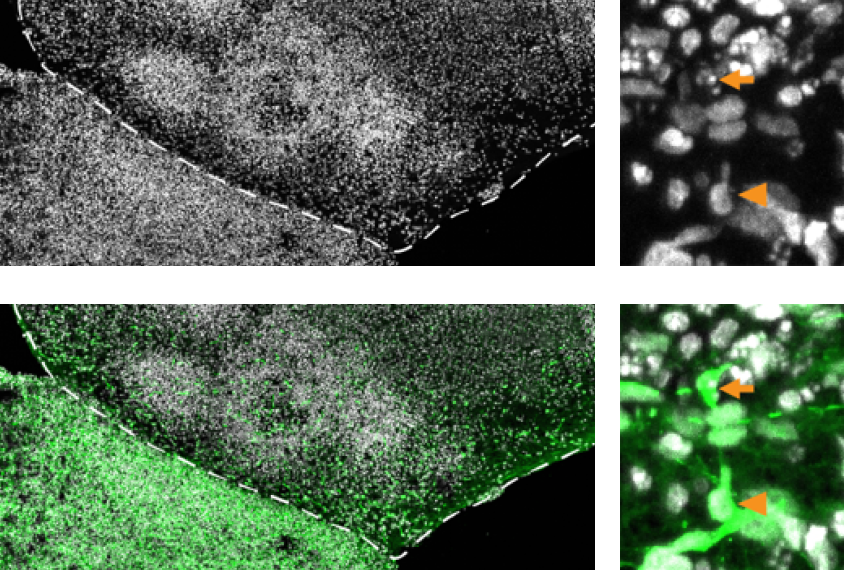Editor’s Note
The preprint mentioned in this story has since been published in Nature.

The model enables the study of autism-linked genes at the earliest stages of neural development.
The preprint mentioned in this story has since been published in Nature.
Roughly 10 percent of genes strongly linked to autism and other neurodevelopmental conditions interfere with the development of interneurons, according to unpublished findings posted on bioRxiv.
The study gleaned the genes’ effects using brain ‘assembloids’ — conglomerations of dissimilar organoids that mimic developing brain tissues such as the cerebral cortex. Assembloids enable scientists to research not just the neuronal makeup of one tissue but the connections and communications between different ones.
Such conglomerations are crucial for studying the development of interneurons, which originate during gestation in a forebrain region called the subpallium (or ventral forebrain) and then migrate toward the cortex. These neurons dampen electrical activity in the brain and have been implicated in autism.
The team mutated the assembloids’ genes one by one, using the gene-editing tool CRISPR. The CRISPR screening process revealed which gene changes hamper interneurons’ development and their trek from one tissue to the other.
“We have a longer and longer list of genes associated with [autism], and we need to find a way of mapping or grouping them to see what processes they impact,” says lead investigator Sergiu Pasca, professor of psychiatry and behavioral sciences at Stanford University.
S
imple cell-culture systems are generally amenable to CRISPR screens, but investigating the hundreds of genes linked to autism within a complex cellular model such as an assembloid can become “quite complicated,” Pasca says.Pasca’s team needed to make each of the CRISPR mutations at the same time for the results to be comparable. So they prepared about 1,000 forebrain assembloids by fusing together individual organoid models of the cortex and subpallium, using a technique they pioneered in 2017.
After culturing the assembloids for about 10 weeks, they used CRISPR to introduce damaging mutations to knock out 425 genes expressed in the ventral forebrain that are associated with autism and other neurodevelopmental conditions. Mutations in 46 of the genes interfered with either the generation of cortical interneurons or the migration of those neurons to different parts of the forebrain.
That relatively small proportion came as a surprise to Alysson Muotri, professor of pediatrics and cellular and molecular medicine at the University of California, San Diego, who was not involved in the study. “It might be that more genes are important, but they are not picked up due to the reductionist nature of the screening,” he says.
The team was able to observe how one gene in particular, LNPK, altered how the endoplasmic reticulum acts during cortical interneuron migration. A 2018 report linked mutations in LNPK, which shapes the endoplasmic reticulum, to a novel neurodevelopmental syndrome associated with autism. The new study helps describe the role that the endoplasmic reticulum plays in interneuron development.
“Ultimately, we want to see: Is each gene going to cause a different form of disease? Or are some of these going to cause similar forms of disease?” Pasca says.
T
he assembloid-CRISPR approach is “a very, very elegant design,” says Jens Schwamborn, professor of cellular and developmental biology at the University of Luxembourg, who was not involved in Pasca’s research.The drawback, Schwamborn says, is the complicated, time-consuming and error-prone process of culturing thousands of assembloids manually. Schwamborn’s lab creates midbrain organoids using robots, an “automated production” method that he predicts will be “the way forward” to culture assembloids.
The screening part of the experiment also presents limitations and is a launching point to do more gene-specific work, says Gaia Novarino, professor of neuroscience at the Institute of Science and Technology in Klosterneuberg, Austria, who was not involved in the study. “Whenever you do screens, you have less understanding of the type of mutations that you are introducing.”
LNPK is just the beginning: Pasca’s lab has started to explore how mutations affect the 45 other genes they linked to interneuron development. Each gene, Pasca says, is its own project.



